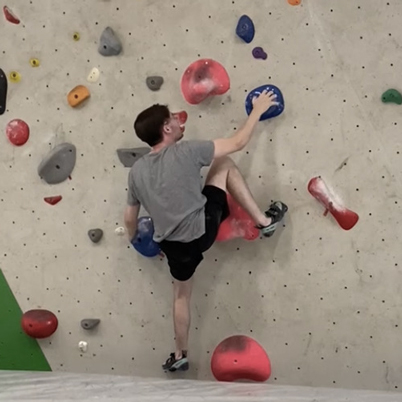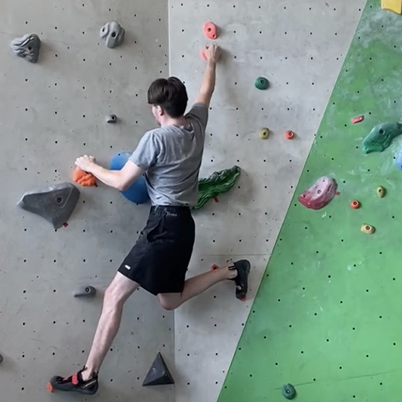Short climbers are disadvantaged at their indoor climbing or bouldering gym. We lack the reach that makes boulder problems and climbing routes look easy. At 5ft3 (163cm), I can count myself among the shorties at my bouldering gym.
With plenty of experience as a short climber, I believe I have enough authority to write this article and help you progress in your own journey as a vertically challenged climber.
One thing I would like to get out of the way first is that just because you are short, doesn’t mean climbing isn’t for you. In fact, there are many shorter climbers out there who have made amazing accomplishments. One prime example is Lynn Hill who became the first climber to free climb the nose of El Capitan in 1993 just at 5ft2 (157cm).
In her own portrayal of the ascent, she explains that her small fingers were the secret weapon that helped her make the infamous first ascent. Being small in stature can definitely form advantages in climbing as well. As I pointed out in my other article, short vs tall climbers.
Hill herself is also a strong believer that climbing doesn’t depend so much on height. And someone as short as her could very well become the best in the world as they will be able to achieve a more ideal strength-to-weight ratio. When she says those things, she is of course talking about real rock where one’s height (or lack thereof) is much less of a disadvantage.
Climbing Techniques for Short Climbers
While short climbers are disadvantaged in reach, they can make up for that by employing climbing techniques to extend said reach.
📚 Related : Complete Guide to Climbing Technique
Use your feet
Climbing with your feet instead of your hands is key to progressing as any type of climber but is especially important for short climbers. Properly using your feet is going to make the difference between you reaching a hold and being inches away from it. Most of the climbing techniques below will include your feet in some way.
Learn to smear
A smear is where you place your foot on the wall (instead of a foothold) and push your feet into the wall. Using this technique can help you reach really far holds.
Here’s how that works:
Imagine you have two footholds at around the same height and your next handhold is too far away. If you don’t move your feet up, you won’t be able to reach for the hold. But there is no foothold there. So what do you do? You move one foot higher up the wall and push (smear) that foot. This way, you can increase your reach by the distance that you smeared.
Smears are often necessary on reachy problems where the route setter probably should have included an extra foothold for shorter climbers.
Continue reading: How to Smear – Climbing Technique 101
Practice using high footholds

By using high footholds, you can push down on that foothold and launch yourself off to the next handhold.
As a short climber, using high footholds is a gamechanger. It might feel weird at first and requires some flexibility, but once you get used to aiming for high footholds, your reach will increase a lot.
Turn your hip in

Most climbers climb with their hips square to the wall. This feels the most comfortable. However, it limits your reach. You can extend your reach a couple of inches further by turning your hip in.
Here’s how that works:
First, you’ll need to have your feet on a foothold in an edge position. While reaching for a far-away hold, turn your hip on the side you are moving towards.
Learn to climb dynamically
Most climbers climb statically. This means the climbers use their reach, in combination with climbing techniques to reach far-away holds.
Dynamic climbing is different. Here climbers use explosive, powerful moves and rely on momentum to reach holds. Climbing dynamically is a great way to increase your reach as a short climber.
Here’s a fun blurb from Dave Macleod’s blog.
For those who find themselves often blaming failure to climb on height or reachy setting – have a few sessions in a bouldering centre like this. Take time to look around you at the short folks slapping and jumping for the holds. You can’t change your height, but you can learn to move your feet into the right position and then go for that hold!
Dave Macleod ‘Through the whole move’ – January 4th 2012 (link)
Dynamic climbing should not be mistaken for dynos though. A dyno is a move where the climber releases all limbs to make an explosive move toward the next hold. During a dynamic move, the climber maintains both feet and one hand on the wall.
Learning to climb dynamically takes some time but it does pay off in the long run.
Here are some tips to climb more dynamically:
- Always warm up beforehand
- Work on your core: core strength is essential in dynamic climbing where you need to have full control and stability on the wall
- Practice good footwork: dynamic moves require pushing with your feet to create that explosive momentum. If your footwork isn’t great, you should work on this before adapting dynamic movements.
- Engage your hips when climbing dynamically
- Practice dynamic movements on easy jugs: you likely won’t need dynamic moves to send easier problems at the climbing gym but this is what you should be focussing on if you wish to improve your dynamic moves on more complex problems!
Tips for Short Climbers
Watch & study short climbers
One of the best thing you can do is study the techniques of other short climbers. As I mentioned earlier, you can watch climbers such as Ashima Shirashi, Seo Chaehyun, and Kim Jain. Find short climbers on YouTube and analyse how they climb. There are a bunch of shorter female climbers on YouTube that have tons of videos for you to go over! Examples are Shortpeoplebeta and Amanda Chan.
Accept that not every route is for you
A tall climber once told me: “the rock doesn’t discriminate”. He was referring to outdoor boulders where nearly everything can be used as a foothold and intermediates can be used as handholds, and being short is not nearly as disadvantageous as it is indoors.
At 6 ft 3 he was frustrated with how ‘easy’ some problems at this indoor bouldering hall were for him. His quote, and the conversation about ‘short vs tall’ we had afterward, left quite an impression on me.
Whether one is short or tall, there will always be boulder problems or climbing routes that seem too easy, too difficult, and too frustrating. Not every problem is going to be for you. And that’s okay!
This doesn’t mean you shouldn’t try, but you also shouldn’t be frustrated when it’s just not within reach.
Yes, you will have to try harder than your taller climbing partners. And you will likely have to adapt the beta if you are going to send the problem. This might bump the grade up for you, without any of the credit. It’s frustrating, but it will make you a better climber.
And once you go outdoors, you will have that experience and use it to your advantage. The rock does not discriminate.
Visit a different climbing gym
I don’t like to blame others, especially route setters, but I have definitely been inside bouldering gyms where the holds just felt unnecessarily far away.
Every boulder gym has reachy problems. After all, tall climbers need to get challenged as well. But every once in a while you will run into a bouldering gym where the problems are just too far away. Over and over.
If the setters can only increase the difficulty by placing the holds far away, they lack creativity and technical vision.
I’ve only come across this a couple of times, but it does happen. Most recently I noticed this at a new bouldering gym near my childhood home. I’ve spent about 10 sessions there now over the course of a couple of months as I visit my dad and I can safely say that they have a case of the ‘just reach’ route setters that the climbing world despises.
The large majority of their walls are vertical (which is an issue on its own for a bouldering gym), making dynamic moves much harder to pull off. So you are left making static moves on problems with very far reaches. This would be fine if it weren’t the same thing over and over. The setting lacks creativity, feels untechnical, and is downright bad.
I only visit this bouldering gym when I absolutely have to. As in I’m visiting my dad and it’s the only climbing gym around.
If you feel this same way, where every hold feels too far away, dynamic movements don’t help and it just feels like the setters are ONLY trying to increase the difficulty by making problems reachy then you might just have to find a different bouldering gym.
Sample different climbing gyms and don’t just get a subscription at the first or even closest climbing gym. Sometimes the problem isn’t just you, it’s the setting.
However, this is not the case in most climbing gyms. Many climbing gyms have shorter setters on their team these days who will set creative, unreachy problems for you to enjoy. On top of that many women are getting into route setting which is super exciting!
Train your flexibility
Short climbers can make up for their lack of reach by increasing flexibility. As mentioned earlier, movements such as hip in and high footholds require a level of flexibility. The more flexibile you get, the more reach you will gain using these climbing techniques. Additionally, increased flexibility will impact the amount of energy and strength you expend during your climbs. A flexibile climber is much more efficient than a non-flexible one!
Daily stretches are key to gaining flexibility. One thing that helped me see rapid progression in climbing is the yoga routine I started incorporating in my daily schedule. Every morning, I would spend 30 minutes doing yoga. It was brutal at first as I was crazy inflexible in the hips due to a childhood fracture which I never recovered from as I never spend any time stretching. But within just a couple of months, I saw a lot of improvement in hip flexibility which translated well into my climbs at the bouldering gym.
I never thought I would be one of those people who would have a daily yoga schedule, but with my obsession for climbing, I had real a reason to do it and it’s become my favorite morning routine!



